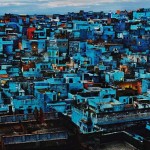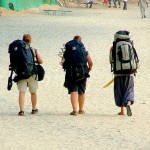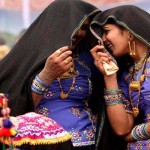Think of swirling colours, a burst of activity, a cultural assemblage of sights and sounds and – wait, are those camels?! If you’ve managed to make your way to Rajasthan by the end of the month, you’re in luck, because you’re going to get to be part of one of the biggest cultural phenomenon’s that the state has to offer – the Pushkar Mela. Wondering what to expect? Here’s what’s in store…
When to head over this year: October 31 – November 6
Where: Pushkar, Ajmer, Rajasthan
5 THINGS YOU SHOULD DO AT THE MELA
1. Go on a camel cart ride. It will seem gimmicky initially, but it’s worth every bumpy movement at the end – just for the experience.
2. Bathe in the lake at the end of the festival, even if you’re not religious. It will be a good chance for you to get a little involved with the cultural aspect of the entire event.
3. Get your hands embellished with temporary tattoos (or permanent ones if you’re bold enough) from local artists.
4. Sing with the locals, or sit back and watch a musician show you his skills.
5. Take a picture with a local – a group of colourfully turbaned men and dancing women are your best bet and are some of the most common tourist images, but we suggest getting one with some of the children of the village.
The small town of Pushkar is incredibly popular through the year, especially for being home to some of the most beautiful temples in the country. Located in Ajmer and home to the Pushkar lake, it’s a tourist hotspot, especially for devout Hindus, and also serves as a pilgrimage site. So, it’s no surprise that as one of the oldest existing cities in India, it’s also home to an annual fair that sees an inflow of locals and foreigners alike, through all five days.
You’ll know you’re at the helm of something truly magical when you see groups of herders and tradesmen making their way past the narrow streets of the town towards the delightful dunes, setting up shop and preparing for the long haul. Settle in for a fun five-days (we suggest a camping tour or something that leaves you closer to the earth and the fair than a swanky hotel) and watch the camels and livestock roll in, shading your eyes from the dust kicked up by excited horses and watching people begin to haggle for the best deals.
Livestock trading is one of the main features of the festival, but it’s not the only one, so you don’t have to wonder what good spending five days at a cattle fair is for a tourist like you. Fill your pockets and saunter around as the days wane on, you’ll do well to be an early visitor at one of the clothing and accessory stalls set up by local women, dotting the sides of the fair.
If you can look above the billowing sand, you’ll be struck immediately by an onslaught of colour, a miasma of hues stretching from locals in brightly coloured turbans and swirling skirts in every shade under the sun. Beware of over-eager photographers scrambling past animals to get the perfect shot (it’s crowded, so make sure you’re in your comfiest gear!) and make friends with a few if you’re not the typical DSLR carrying tourist, to capture the memory of the event. Once you find yourself a comfy spot, sit tight and wait for the shows to begin – and there will be a lot of them! If you’re lucky, you’ll find friendly local families to pose with (beware of those who ask for money!) and scour the masses for the interesting titbits.
The sleepy town seems to be set on fire all of a sudden as the camel races begin. A camel race is a suspicious concept, but a delightful vision when it’s happening live!
If you’ve managed to stay till there’s a slight lull in the events, saunter past majestic camels, put on display especially to entice the humble tourist and almost regal as they stand in the swirling sand dunes. For those who want a little more activity, turn away from the camels and towards the exhibition cricket matches, held between local clubs and several visiting teams (sometimes even teams made up of foreigners who are visiting the area). There’s also games, contests, dance and cultural shows – there’s so much going on that you won’t know when the five days have escaped you! And if you’ve got it in you to enter one of the contests, make sure you’re as colourfully and wildly dressed as the locals. It’s not as intense as cosplay, but unless you’ve got local attire that can beat the locals out of the water, your best bet is to watch as bridal and moustache competitions sweep the area.
While the camel and livestock are the main attractions, the cultural fair is one of our favourites and if you’re a passing tourist, will be yours too. If you’re bold enough to get a tattoo, you can cement your memory of the visit, and if you’re not, waltz past the tattoo stalls and pick up some knick-knacks instead, stopping to watch a puppet show on the way. Homeowners can also get some interesting things for their homes and kitchens – local arts and crafts in Pushkar really can’t be beaten by too many others.
With musical acts, lights swirling through the desert sky and people shouting out over the heavy sound of camel hooves and horse trots, this is one fair you’re never going to forget. On the final day, you can see almost the entire town, along with several devout tourists and some intrigued foreigners taking a dip in the lake. The holy dip is so popular that it can get pretty full, so it’s a good idea to wait till it’s died down a little before you dip your toes in if you wish to.
For a little town that’s lost in time if you visit off season, Pushkar really comes alive when it’s time for the fair to begin. Whether you’re visiting just for the fair or stopping over during a visit to the majestic state, we can tell you one thing for sure – this is not something you should be missing out on.
FACING FACTS
The entire town of Pushkar gathers on the banks of Pushkar lake during this time every year for a fair that’s definitely one to remember. But, how did it start and what is it really about?
Celebrated for five days every year, from Kartik Ekadash to Kartik Poornima (which is the full moon day), this is one mela that’s filled with history. Legend has it that Hindu god Brahma sprung up from the lake and so several people use the lake to swim in during the festival as they deem the water sacred. The area is home to the only Brahma temple in the world and so holds a lot more significance. The fair is traditionally the world’s largest camel fair, where several thousand camels are gathered and livestock trading is indulged in along with some interesting events, races and competitions. It’s become quite a tourist attraction off late, so there’s now a lot more reasons to head over than just to get a glimpse of some heavily decorated camels.
Nicole
Latest posts by Nicole (see all)
- Top 10 Winter Destinations for Snow Lovers in India - November 5, 2021
- 13 Uses of a Swiss Army Knife While Travelling - November 3, 2021
- 13 Types of Travellers You Don’t Want to Travel With - October 28, 2021























